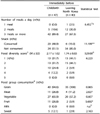5. Choue RW, Hong JY, Yim JE. The changes of dietary intakes in the defectors from North Korea. Korean J Community Nutr. 1997; 2:470–476.
6. Park YS, Rhee KC, Lee KY, Rhee EY, Yi SH, Kim DN, Choi YS. A glance at the health status and food intake of North Koreans. Korean J Community Nutr. 1997; 2:396–405.
7. Chang N, Jo D, Hwang J, Kang E. Assessment of health and nutritional status of North Koreans utilizing an exhaustive literature search and survey. Korean J Nutr. 1998; 31:1338–1346.
8. Park YS, Rhee KC, Lee KY, Rhee EY, Yi SH, Kim DN, Choi YS, Seok D. Dietary living in North Korea according to the defectors. Korean J Community Nutr. 1999; 4:64–73.
9. Chang NS, Hwang JY. Food shortage, nutritional deprivation, and reduced body size in North Korean defectors. Korean J Nutr. 2000; 33:540–547.
10. Hwang JY, Chang N. Dietary patterns and nutrient intake in North Koreans by utilizing literature search and survey. Korean J Community Nutr. 2001; 6:371–379.
11. Chang N, Kang EY, Lee JM, Lee MK. Anthropometric measurements and dietary patterns of North Korean migrant children in China. Korean J Nutr. 2000; 33:324–331.
12. Shim JE, Yoon J, Jeong SY, Park M, Lee YS. Status of early childhood and maternal nutrition in South Korea and North Korea. Korean J Community Nutr. 2007; 12:123–132.
13. Barker DJ. Fetal and Infant Origins of Adult Disease. London: British Medical Journal Group;1992.
14. Barker DJ. Mothers, Babies, and Disease in Later Life. London: British Medical Journal Group;1994.
15. Gluckman PD, Hanson MA. Developmental Origins of Health and Disease. Cambridge: Cambridge University Press;2006.
17. Choi SK, Park SM, Joung H. Still life with less: North Korean young adult defectors in South Korea show continued poor nutrition and physique. Nutr Res Pract. 2010; 4:136–141.

18. Lee SK, Nam SY. Comparison of food and nutrient consumption status between displaced North Korean children in South Korea and South Korean children. Korean J Community Nutr. 2012; 17:407–418.

19. Coates J, Swindale A, Bilinsky P. Household Food Insecurity Access Scale (HFIAS) for Measurement of Food Access: Indicator Guide. Version 3. Washington, D.C.: Food and Nutrition Technical Assistance Project;2007.
20. Swindale A, Bilinsky P. Development of a universally applicable household food insecurity measurement tool: process, current status, and outstanding issues. J Nutr. 2006; 136:1449S–1452S.

21. Becquey E, Martin-Prevel Y, Traissac P, Dembélé B, Bambara A, Delpeuch F. The Household Food Insecurity Access Scale and an index-member dietary diversity score contribute valid and complementary information on household food insecurity in an urban West-African setting. J Nutr. 2010; 140:2233–2240.

22. Knueppel D, Demment M, Kaiser L. Validation of the household food insecurity access scale in rural Tanzania. Public Health Nutr. 2010; 13:360–367.

23. Regassa N, Stoecker BJ. Household food insecurity and hunger among households in Sidama district, southern Ethiopia. Public Health Nutr. 2012; 15:1276–1283.

24. Weiser SD, Frongillo EA, Ragland K, Hogg RS, Riley ED, Bangsberg DR. Food insecurity is associated with incomplete HIV RNA suppression among homeless and marginally housed HIV-infected individuals in San Francisco. J Gen Intern Med. 2009; 24:14–20.

25. The Korean Nutrition Society. Dietary Reference Intakes for Koreans. Seoul: The Korean Nutrition Society;2010.
26. Savy M, Martin-Prével Y, Traissac P, Eymard-Duvernay S, Delpeuch F. Dietary diversity scores and nutritional status of women change during the seasonal food shortage in rural Burkina Faso. J Nutr. 2006; 136:2625–2632.

27. Arimond M, Ruel MT. Dietary diversity is associated with child nutritional status: evidence from 11 demographic and health surveys. J Nutr. 2004; 134:2579–2585.

28. Cordeiro LS, Wilde PE, Semu H, Levinson FJ. Household food security is inversely associated with undernutrition among adolescents from Kilosa, Tanzania. J Nutr. 2012; 142:1741–1747.

29. Schwekendiek D. The effect of the seasons of the year on malnutrition in North Korea. Homo. 2009; 60:59–75.

30. Robinson WC, Lee MK, Hill K, Hsu E, Burnham G. Demographic methods to assess food insecurity: a North Korean case study. Prehosp Disaster Med. 2001; 16:286–292.







 PDF
PDF ePub
ePub Citation
Citation Print
Print




 XML Download
XML Download